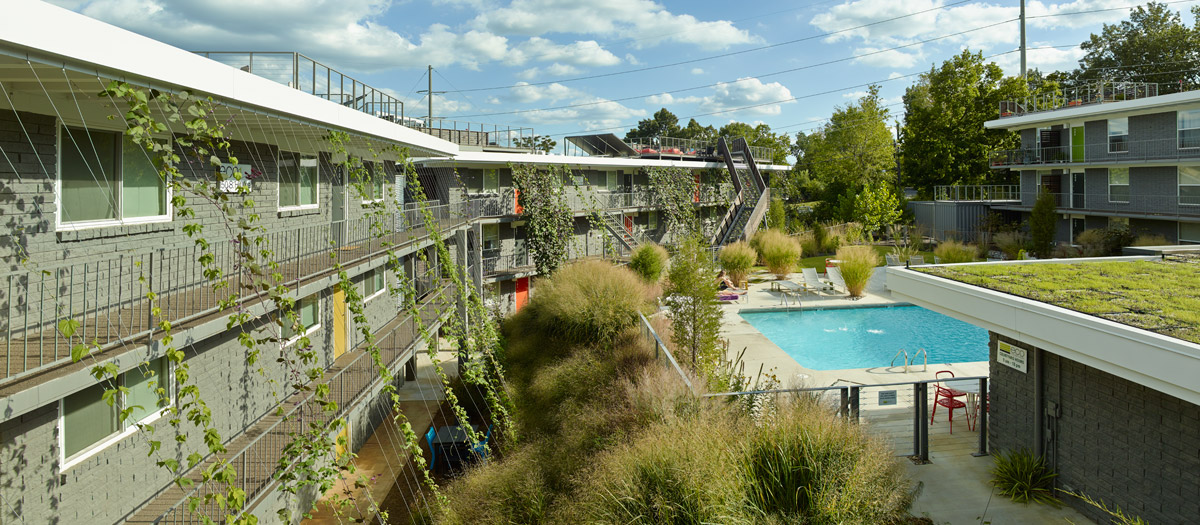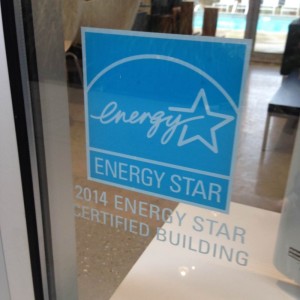
EPA announced seventeen pioneering properties nationwide
We’re excited to share the news that the U.S. Environmental Protection Agency has recognized ECO Modern Flats among the first multifamily housing properties to earn ENERGY STAR certification for superior energy performance. The recognition signifies that this pioneering property is more energy efficient than 75 percent of similar properties nationwide, and that it is one of the first to tap the energy efficiency potential within the multifamily housing industry.
By reducing the amount of energy consumed, ECO Modern Flats has cut utility bills and reduced greenhouse gas emissions associated with producing energy. Current estimates show that multifamily properties can become 30 percent more efficient by 2020, unlocking $9 billion in energy savings and preventing annual greenhouse gas emissions roughly equivalent to the average annual output from over four million U.S. households.
“Specialized Real Estate Group is pleased to accept EPA’s ENERGY STAR certification in recognition of our energy efficiency efforts,” said Jeremy Hudson, Specialized CEO. “We designed this building to save energy, and ENERGY STAR confirms that we’ve met that goal. Efficient operations are a cornerstone of our commitment to creating healthy places.”

Along with ECO Modern Flats, 16 other multifamily buildings were also among the first to earn EPA’s ENERGY STAR for existing buildings. They are:
- 30-50 21st, in New York, N.Y.: Owned by NYSANDY2 30-50 21ST LLC, managed by Related Management and with technical assistance from Bright Power
- 680 North Lake Shore Drive, in Chicago, Ill.: Owned and managed by Golub & Company, with technical assistance from Goby, LLC
- The Ashley at RiverHouse, in Arlington, Va.: Owned and managed by Vornado/Charles E. Smith
- Aspira Apartments, in Seattle, Wash.: Owned by TIAA-CREF, managed by Riverstone Residential Group and with technical assistance from JDM Associates
- Avalon The Albemarle, in Washington, D.C.: Owned and managed by AvalonBay Communities, Inc
- Castle Square, in Boston, Mass: Owned by CSTO Winn Owner LLC and managed by WinnResidential
- Circa Green Lake Apartments, in Seattle, Wash.: Owned by TIAA-CREF, managed by Pinnacle and with technical assistance from JDM Associates
- Harvard School of Public Health – Shattuck International House, in Boston, Mass.: Owned by President and Fellows of Harvard College and managed by Energy Management Associates, Inc.
- Jeffery Parkway, in Chicago, Ill.: Owned and managed by Nautilus Investments, with technical assistance from Elevate Energy
- MidAtlantic – DC: The Statesman, in Washington, D.C.: Owned and managed by AvalonBay Communities, Inc.
- Peter Cooper Village, in New York, N.Y.: Owned and managed by CompassRock Real Estate
- Prescott Wallingford, in Seattle, Wash.: Owned by TIAA-CREF, managed by Riverstone Residential Group and with technical assistance from JDM Associates
- River City, in Chicago, Ill.: Owned and managed by Marc Realty, and with technical assistance from Goby LLC
- Stuyvesant Town, in New York, N.Y.: Owned and managed by CompassRock Real Estate
- Terrific Tenements 423 W 48th Street, in New York, N.Y.: Owned by Clinton Housing Preservation, LP, managed by Related Management, and with technical assistance from Bright Power
- Terrific Tenements 527 W 47th Street, in New York, N.Y.: Owned by Clinton Housing Preservation, LP, managed by Related Management, and with technical assistance from Bright Power
“Specialized Real Estate Group’s achievement demonstrates that it’s possible to overcome the many traditional barriers to energy efficiency in the multifamily housing market and reap significant energy and cost savings,” said Jean Lupinacci, Chief of the ENERGY STAR program for Commercial and Industrial Buildings. “Through the example they’ve set, we see how we can all help to make properties more cost-effective for renters, while cutting greenhouse gas emissions and protecting human health.”
Energy costs for renters have risen by 20 percent on average over the past decade, so energy efficiency represents a significant opportunity to reduce utility costs and the greenhouse gas emissions associated with the production of energy, which contribute to climate change.
ENERGY STAR certified buildings use an average of 35 percent less energy and are responsible for 35 percent fewer carbon dioxide emissions than typical buildings. Many types of commercial buildings can earn the ENERGY STAR, such as office buildings, K-12 schools, hotels, and retail stores.
The new 1-100 ENERGY STAR score and certification for existing multifamily properties is based on nationally representative survey data provided by Fannie Mae and will be integrated into other green building certification programs, including the U.S. Green Building Council’s popular Leadership in Energy and Environmental Design rating system. It is the first time existing multifamily properties have been able to be certified as ENERGY STAR. Previously, only new construction multifamily properties have been able to earn certification by meeting prescriptive design requirements for high performance.
ENERGY STAR is the simple choice for energy efficiency. For more than 20 years, people across America have looked to EPA’s ENERGY STAR program for guidance on how to save energy, save money, and protect the environment. Behind each blue label is a product, building, or home that is independently certified to use less energy and cause fewer of the emissions that contribute to climate change. Today, ENERGY STAR is the most widely recognized symbol for energy efficiency in the world, helping families and businesses save $300 billion on utility bills, while reducing greenhouse gas emissions by two billion metric tons since 1992.
More on the first multifamily properties to earn the ENERGY STAR

